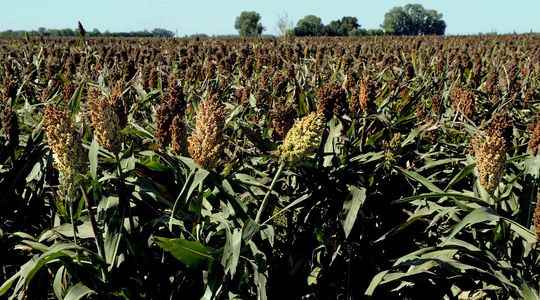Lowest river flows, reduced water tables, prefectural decrees limiting the use of water, and still no heavy rainfall on the horizon… Farmers are brooding. For them, it is becoming more and more difficult to irrigate, to the point that some are wondering if sorghum, this cereal of African origin, should not be planted to the detriment of certain crops less adapted to climate change, such as maize. .
“2022 will perhaps be a year of awareness and acceleration towards crop diversification,” hopes Serge Zaka, agroclimatologist at ITK. For the time being, sorghum represents only 5% of cultivated areas. But it is undeniably one of the cereals of the future. “Its optimum growth temperature is the highest of all the most consumed cereals: 35 degrees, against 27 for wheat and 31 for corn”, specifies Serge Zaka. Its development cycle is also shorter: 120 to 130 days to reach maturity, compared to 125 to 180 days, on average for maize. Finally, sorghum has a more efficient water use system due to its leaf structure. Ultimately, therefore, it requires less water.
“This cereal is relatively simple to cultivate. It has practically the same qualities as corn in animal feed. It is very rich in protein. And the human outlets on which we could work abound”, explains Yvon Parayre administrator and president of the Sorghum Commission to the General Association of Wheat and Other Cereals Producers (AGPB).
Gluten-free, rich in iron and vitamins (B3, B6), sorghum is used to make pasta, cookies, beer or strong alcohol. “In China, it is used in the composition of baijiu, a white alcohol whose price far exceeds that of our spirits: more than 300 euros for a container of 37 centilitres. Sorghum can therefore generate a lot of value, but few people know”, laments Frédéric Guedj, responsible for the development of this market in Europe, at the French seed company Lidea.
A false start in 2019
Why, despite its many assets, does sorghum cultivation remain so underdeveloped in France? “There was indeed a jump in 2019. We were emerging from a period of drought. Everyone wanted to do some. We had even exceeded 100,000 hectares cultivated, which had resulted in a temporary shortage of seeds “, recalls Yvon Parayre.
Except the spark didn’t take. Some disappointed farmers switched to other crops the following year, such as sunflower. “We are still in a transition period, justifies Serge Zaka. In the future, it will be more profitable to grow sorghum rather than corn. Indeed, 2022, with its repeated drought periods, will look like a classic year around 2040/2050. And towards the end of the century, the whole of France will become an optimal production area for sorghum. But for the moment, its profitability remains variable and not always sufficient”, details Serge Zaka. Farmers therefore do not necessarily change their habits.
“Many people still know little about sorghum, notes Frédéric Guedj. Some believe it is rich in tannin (which would reduce the energy value of the foods that are made with it) but this is not the case. Others underestimate its protein content…Finally, some farmers do not do the right cultivation.They put too much nitrogen, wait too long to harvest it or do not plant it deep enough in the ground”. There is therefore still a lot of educational work to be done. “For this culture to take hold in France, there must also be an economic structure behind it, a real sector with all its links: production, harvest, storage, processing, distribution, consumption”, explains Serge Zaka.
For the moment, the account is not there. “Some storage organizations refuse to make sorghum because of insufficient volumes. Unfortunately, it’s the same thing for seeds, maintenance products, fertilizer…”, indicates Yvon Parayre. Another obstacle: “in Europe, unlike the United States, we still do not have official prices for sorghum. There is simply an arbitrary quotation, the value of which remains lower than that of corn”, confides Frédéric Guedj.
“The State must play its role to drive change. It is not a question of replacing maize, but of introducing more diversity, which would allow farmers to reduce their water needs”, warns Serge Zaka. Europe can also serve as a driving force. “CAP support would motivate farmers to grow sorghum, as happened in the 1980s for sunflowers,” thinks Frédéric Guedj. “It’s not just sorghum. It’s time to look at other interesting crops like millet – another African cereal – pistachio or rapeseed”, adds Serge Zaka. Although there are still many studies to be carried out on these plants, their essential properties are known. Now is the time to move from science to the fields.
